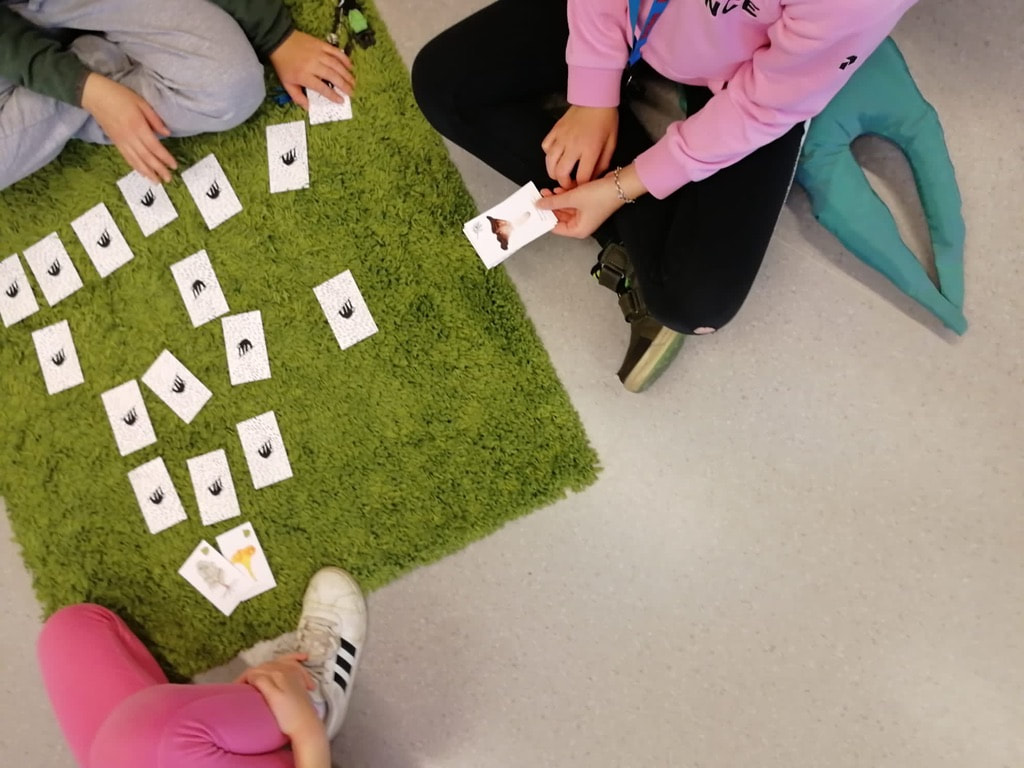Symbiosis
|
Mystery of Mycorrhiza – memory card game
Age: 6+ Number of players: 2-6 people Time: 20-30 minutes Contents: 52 playing cards Introduction: Imagine you are so small that you can crawl among the teeny tiny particles of the soil. Keep on crawling until you end up beneath the ground. Here you can start to observe life in the soil. Next to you is an extensive network of tree roots and mycelia that meanders around the soil. Trees and fungi can form mycorrhizae together. Mycorrhiza is a structure, where the mycelium of the fungus grows on top of the thin root of the tree. The mycorrhiza is a hotspot for the active change of ingredients important for both of its partners: the tree gives sugars to the fungus, which the fungus cannot produce itself. The mycelia of the fungus collect nutrients from the soil, such as nitrogen and phosphorus, but also water, and then hands them over to the tree. The tree and the fungus live in symbiosis with one another, which is an interaction where both partners benefit. Some of the fungi species live in symbiosis with only one tree species while others form mycorrhizae with many different types of tree species. Not every kind of symbiotic relationship between the trees and the fungi is known yet. The mycelia of the fungi unite tree roots into an underground network. One individual tree may have various kinds of mycorrhizae in its roots, formed with different kinds of fungi. Some fungal species that form mycorrhizae grow a mushroom on the ground surface in order to reproduce. However, mushrooms that are seen on the ground, like bolete or fly agaric, are only a small part of fungi individuals living in symbiosis with the tree. Moreover, some of the mycorrhizal fungi live completely underneath the ground. In this memory game, we have focused only on fungi species that produce mushrooms. You can get to know these fungi species better here. Enjoy the game! |
|
– – – – – – – – – –
Preparations before the game: Get to know the pictures on the cards. There are two kinds of them: mushroom and tree cards. Cut the cards from each other along the dashed line. Game instructions: The aim of the game is to collect the most cards. Matching pairs are tree and mushroom species that can form mycorrhizae together. Game continues until there are no cards left on the table. To help you to identify and learn correct symbiotic pairs, we have added a little symbol of the leaf or needle on top of each mushroom card which guides you to connect the correct tree species with its symbiotic mushroom species. Same tree specific symbols are presented also on the tree cards. Before the start of the game, shuffle the cards carefully and place them on the table, the picture side facing down. Every player can turn over two cards face up on their own turn. If the player finds a mushroom card and a tree card with the same symbol, the player wins the pair and can play again. Cards do not match if a player turns over two mushroom cards, two tree cards, or a tree card and mushroom card with non-matching symbols. In this case, the player turns the cards face down and shift passes to the next player. Exceptionally in this game you can also win 3 or 4 cards in the same round. For example, if the player turns over a mushroom card with two tree symbols, the player can choose a third card as well. If the player then finds a mushroom card with matching two tree cards, a “triple” is formed, and the player wins all the three cards. An example: If you have turned over a fly agaric and pine, you can turn over a third card. If it happens to be a birch tree card, then you have won the triple! To win the four cards, you need to find a mushroom card with three tree symbols. With this card you can turn over three cards instead of one or two. An example: If you have turned over a curry milkcap card, you also need to find birch tree card, pine tree card and spruce tree card in the same round. If you manage to do that - congratulations! You have won four cards! Note: In this game, two similar tree species do not form a pair. In nature, trees cannot form mycorrhizae with each other without the fungus. In order to form the mycorrhiza, you always need a tree and a fungus together. The game ends when all the cards have been collected. The winner is the player with the most cards. After the game: You can celebrate the fair and good game and fantastic fungal world with a delicious mushroom dinner, or by making a trip to the nearby forest - how many symbiotic pairs can you find there? You can take your mushroom and tree cards with you and use them as your mycorrhiza guidebook. |
|
– – – – – – – – – –
Our materials are licensed under the Creative Commons Attribution-ShareAlike 4.0 International License: http://creativecommons.org/licenses/by-sa/4.0/. It means you can use our materials freely, but please remember to always credit our work and mention us whenever you are sharing contents of our project online: Instagram: @evolution_in_action, Facebook: @evoluutiopajat, Twitter: @EvoWorkshops. If you use our materials in teaching, we are happy to hear greetings and feedback. You can tag us on social media or send us an email: [email protected] Evolution in Action logo: jpeg, eps |

